
| Military Rifles 1894-1960 |
|
Military Semi-auto rifle Ag m/1942 |
|
Military & FSR
Rifles 1960-2019 |
|
Military Rifles 1990-2019 |
|
Ag 90 (Barrett 82A1) |
Ljungman semi-automatic rifle
Text and pictures by O. Janson
Uppdaterad 2019-04-18
|
Extra equipment Ag m/42B |
 |
|
|
The same bayonet was used like for rifle m/96, m/38, Ag m/42 and Ag m/42B. |
|
|
There was a blank firing device which made the semi-automatic rifle work properly for peace time training. |
|
|
A simple sight for low light was issued, which could be put on top of the ordinary sights.
Here mounted on top of rear sight.
|
|
|
| Every gun was issued with a toolbox. | |
 |
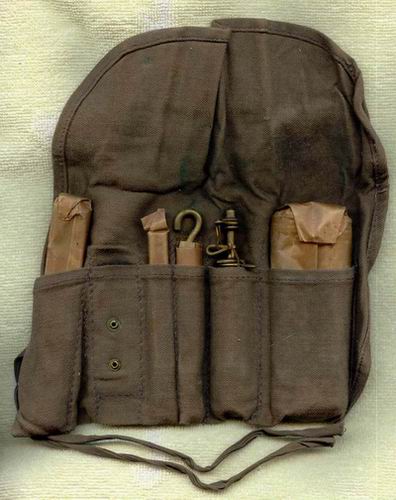 |
 |
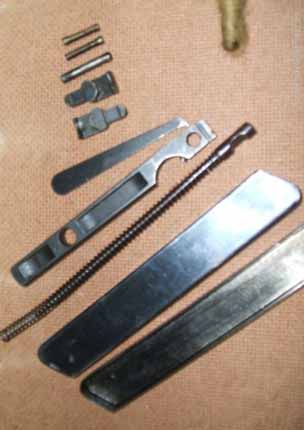 |
| Inside of the toolbox-bag looks like this | |
 |
The
toolbox contained an
ordinary twin oil can with the brush, a universal tool, another tool with flax
all around to clean the chamber. One small squirt can for oil. This squirt can
should be used to drip oil on the cartridges in case of feeding problems.
There was also a small box of
steel with spare parts.
|
Loading and field stripping.
|
Please
note a special rule: Loading - the safety much stand in
FIRE
position (to the left)! For ALL OTHER actions the weapon shall be handled with the safety in SAFE position to the right! |
 |
Move the cover for the bolt carrier forward as long as possible and pull subsequently back to the rear position. |
|
|
Put a cartridge clip in the recess for the clip in the frame, introducing the UPPER knobs of the clip in the grooves.
|
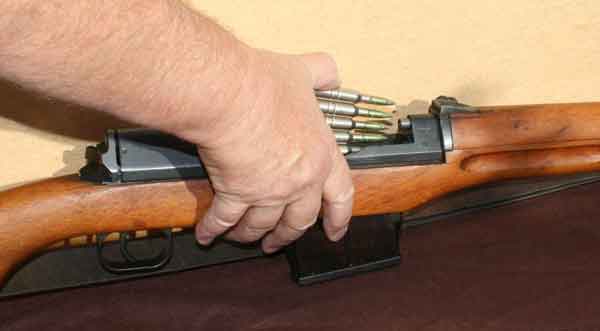 |
Push the cartridges down in the magazine with the right hand. Take away the empty clip. Load another clip the same way.
|
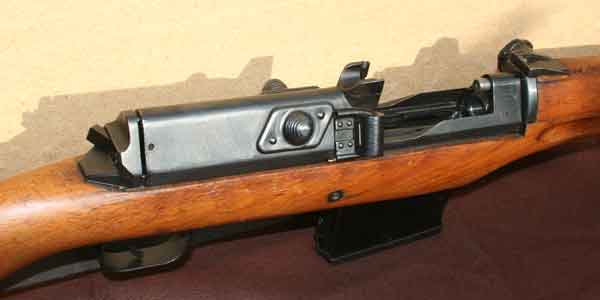 |
Push the cover forward with the
right hand as long as possible about 3 – 4 mm and pull firmly back.
Now the bolt and the bolt carrier are thrown forward collecting the top cartridge from the magazine. Adjust the safety to the position safe. |
|
The weapon is now loaded and put to safety. When the last
cartridge has been fired, the bolt and the locking piece are cocked in the rear
position by the bolt catch.
|
Removing cartridge from the chamber.Make sure the safety is on! Push the cover forward with the right hand as long as possible, and then backwards. Move the cover backwards but not so long that the base of the cartridge touches upon the ejector. Hold your fingers to prevent the cartridge from being thrown out from the receiver. Repeat this until the magazine is empty. Be sure that the weapon is in safe position! Press down the magazine feeder and push the cover forward as long as possible. Press in clasp of the cover with the thumb of your right hand. Release cover slowly in backward direction. WARNING! If you do the operation above with safe in OFF position the result will most likely be a painful bloody thumb! Among the Swedish soldiers, a thumb hurt in such away, was called an “Ag-thumb” and it was much joked about!
Release the safety, fire on an empty chamber in a safe direction and twist the safety to safe position again. |
|
The safety is on! Remove the magazine by pressing the locks in both ends (Ag m/42B). Move the cover fully to the foremost position.
DO NOT PULL THE TRIGGER when the bolt and boltcarrier have been removed!
It will damage your rifle!
|
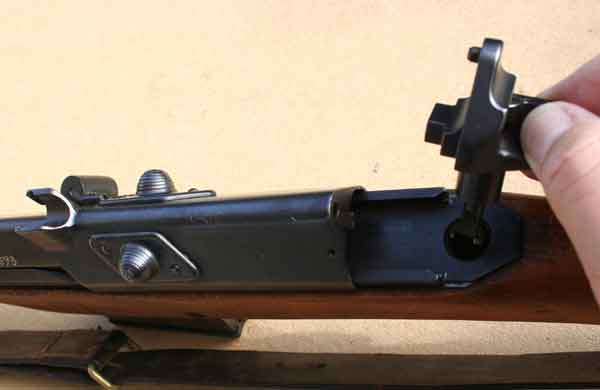 |
Turn safety lever straight backwards and lift the back piece with the safety out from the rifle. |
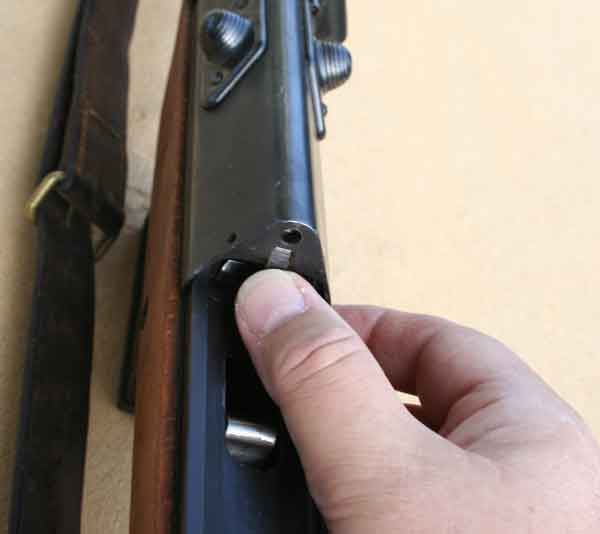 |
Press down the clasp of the cover
releasing it from locking piece. Hold the cover with your firm hand and release it slowly backwards. |
|
|
Take away the cover and the recoil springs. Take away the bolt carrier (locking piece) and the bolt.
|
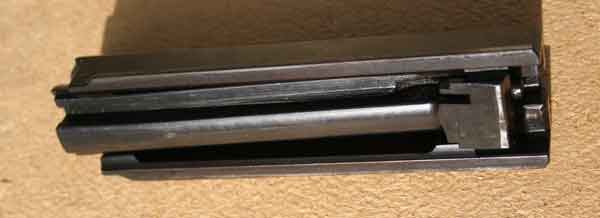 |
Hold the bolt carrier upside down
in your left hand with the bolthead directed forwards.
Catch the bolt with thumb and forefinger of your right hand and raise the bolts rear part so that the locking lugs come above the grooves in the bolt carrier. Move the bolt forward while you twist it a little and lift it out of the bolt carrier. |
 |
Far left: Back piece with the safety Top right: Middle: Bottom:
|
|
The parts of Ag m/1942. You can click on this image to see a much larger. |
|
Insert the bolt in the bolt carrier in reverse order. Return the bolt carrier to the receiver. Now the hammer must be pressed down Wait to insert the magazine until you have assembled the rifle. Insert the recoil springs in the bolt carrier and the cover when you move the cover back to its foremost position so it will engage and lock to the bolt carrier. Return the back piece with the safety and turn the safety to the left. Release the cover by pressing the clasp down and let the cover come slowly to its rear position. Fire on an empty chamber and put the safety in safe position to the right. |
| Characteristics of the Swedish Ag m/1942 | |||
| Length over all | 1217 mm | Barrel length | 637 mm |
| Weight | 4,4 kg | Grooves | 6 grooves right hand twist. |
| Calibre | 6,5x55 Swedish | Sight RN prj m/1894 | 100-600 m |
| Muzzle velocity: | 745 m/s (2450 fps) | Sight Torpedo prj m/41 | 100 - 800 m |
| System of operation: | Gas-operated | Function | Semiautomatic only. |
|
There were attempts to further develop the Ag m/42 to an assault rifle which you can read about in an article at a different place on this website Swedish military assault rifles 1945 – 1990, Ak4 and Ak 5. These test weapons were never accepted. After the acceptance of the Swedish assault rifle Ak 4 (G3) the Ag m/42B were melted down but some were sold abroad to arms dealers who sold them to collectors. |
Variants of Ag m/42The Ag m/42 was also manufactured in Denmark by Dansk Industri Syndikat, Madsen. The Madsen version had a longer gas tube coiled around the barrel to improve accuracy, however this made the cleaning of the tube more difficult. This version was never accepted by the Danish army so its life span became very short.
|
|
|
Egyptian Hakim (Ljungman) rifle in calibre 7,92x57
|
|
Around 1950 Egypt set up a manufacturing plant ‘54 later known as Madi Industries Inc. with the assistance of Swedish technicians from a company in Sweden called “Internationella Gevars Aktiebolaget” (I.G.A.B) This plant manufactured Ag m/42 under license in 7,92x57 mm and 7,62x39. These rifles are known as Hakim rifles. The plant also made the Port Said submachine gun in 9 mm which is a Swedish Carl Gustaf m/45 submachine gun. Sweden withdrew the licens, but Egypt kept on manufacturing these rifles anyway for years. The production of these rifles and machine guns has now stopped since many years.
|
|
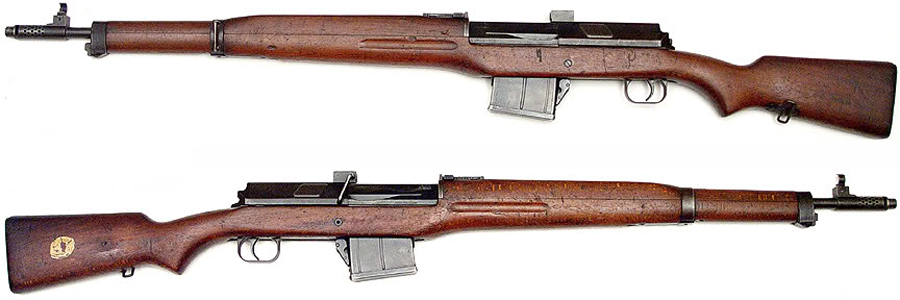
Bayonet for the Hakim |
|
References: Karl-Olof Björsell, Gothia Arms Historical Society annual magazine No 14, 1995 Claes-Goran Roos, EVhS Instruction manuals for the Swedish army 1939 to 1983. Josef Alm, Arméns eldhandvapen förr och nu, 1953 Vapenmuseet, Eskilstuna Sweden Joseph E. Smith and W.H.B. Smith 10th Edition of Small arms of the World 1973, ISBN: 0-89104-021-8 Ian Hogg & John Weeks, Military small arms of the 20th century, 1973, SBN 85368 319 0
|
| Military Rifles
1894-1960 |
|
Military Semi-auto rifle Ag m/1942 |
|
Military & FSR
Rifles 1960-2019 |
|
Military Rifles 1990-2019 |
|
Ag 90 (Barrett 82A1) |